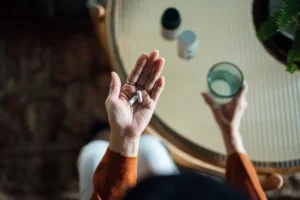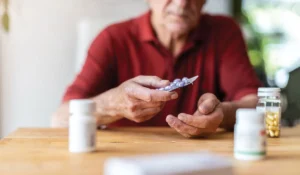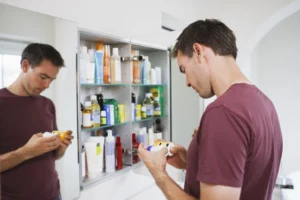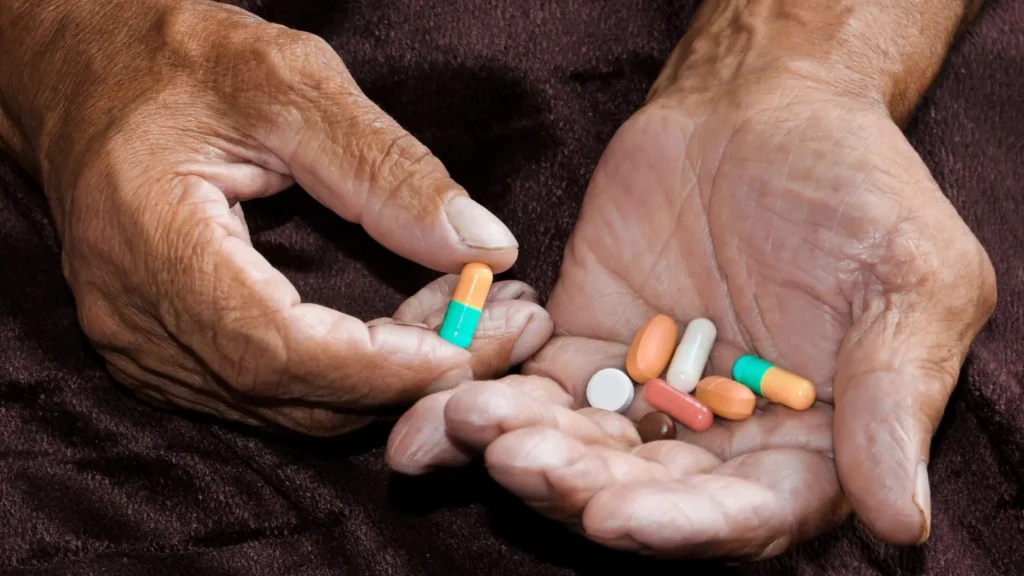Have you ever had such bad back pain or a muscle strain that you felt you’d try anything to get relief? Maybe your doctor suggested Robaxin (Methocarbamol), a muscle relaxant designed to ease that kind of severe discomfort. While it can be a real lifesaver, some people worry: could this medication be addictive?
In this blog, we’re diving deep into what Robaxin is, how it’s used, and its side effects. We’ll tackle the big question—Is Robaxin addictive?—and discuss what to do if you or someone you know might be using it too much. Whether you’re considering this medication for yourself or you’re just curious about its effects, we’ve got all the information you need right here. Let’s get to the bottom of these concerns and find out how to use Robaxin safely and effectively.
Contents
What is Robaxin (Methocarbamol)?
 Robaxin, known by its generic name Methocarbamol, is a muscle relaxant medication that doctors prescribe to relieve muscle spasms and pain. It is commonly used in conjunction with rest, physical therapy, and other treatments to help relax muscles and make movement easier in conditions involving acute skeletal muscle spasms.
Robaxin, known by its generic name Methocarbamol, is a muscle relaxant medication that doctors prescribe to relieve muscle spasms and pain. It is commonly used in conjunction with rest, physical therapy, and other treatments to help relax muscles and make movement easier in conditions involving acute skeletal muscle spasms.
How does Robaxin work? It primarily acts on the central nervous system (CNS) rather than directly on the muscles. By reducing the nerve impulses that cause muscle spasms, Robaxin helps to ease discomfort and improve mobility in affected areas.
Common Uses in Medical Treatment: Robaxin is typically prescribed for:
- Muscle spasms: Often caused by conditions like back pain or injuries from accidents.
- Acute pain management: It helps manage pain resulting from muscle strains or sprains.
- Post-surgery treatment: Used to relieve muscle pain and spasms following orthopedic surgeries.
It’s important to use Robaxin exactly as prescribed by a healthcare provider. Overuse or misuse can lead to potential complications, including dependency. In medical settings, Robaxin is regarded as effective for short-term use, especially during the initial stages of treatment for acute muscle conditions.
Is Robaxin Addictive?
 One of the key concerns for anyone taking a new medication, particularly one that affects the central nervous system, is its potential for addiction. Robaxin (Methocarbamol), as a muscle relaxant, does raise questions about its potential for dependency and abuse, although its profile differs significantly from opioids and other highly addictive substances.
One of the key concerns for anyone taking a new medication, particularly one that affects the central nervous system, is its potential for addiction. Robaxin (Methocarbamol), as a muscle relaxant, does raise questions about its potential for dependency and abuse, although its profile differs significantly from opioids and other highly addictive substances.
Addictive Properties of Robaxin:
- Low Potential for Abuse: Robaxin is generally considered to have a low potential for abuse. Unlike opioid pain medications, it does not produce the euphoria that typically leads to substance misuse.
- Dependency Risk: While the risk of developing a dependency on Robaxin is relatively low, it can still occur, especially with long-term use beyond the recommended duration. Dependency is more about the body becoming accustomed to the presence of the drug rather than an addictive craving.
Medical Research and Expert Opinions:
- Medical professionals generally regard Robaxin as safe when used as directed. The primary concern is not addiction per se but ensuring that it is part of a comprehensive treatment plan that includes physical therapy and other non-pharmacological approaches to muscle relaxation.
In conclusion, while Robaxin is not typically associated with the high addictive potential seen in other pain relievers like opioids, it is crucial to use it responsibly and under medical supervision to avoid any potential health risks associated with its misuse.
Side Effects of Robaxin Addiction
While Robaxin (Methocarbamol) is effective in treating muscle spasms, like all medications, it can cause side effects. Most of these are mild and may diminish as the body adjusts to the medication. However, some side effects can be serious and require medical attention.
Minor Side Effects:
- Dizziness and Drowsiness
- Headache
- Nausea and Vomiting
- Blurred Vision
More Serious Side Effects:
- Allergic Reactions such as rash, itching, or swelling, especially around the face, tongue, and throat
- Jaundice
- Seizures
- Confusion or Severe Drowsiness
Immediate medical attention should be sought if symptoms of an allergic reaction, seizures, or jaundice appear. If the more common side effects become bothersome or do not go away, it’s important to consult with a healthcare provider. They may adjust the dose or switch medications if necessary.
The Risk of Dependency and Overuse
 While Robaxin (Methocarbamol) is generally considered to have a lower risk of dependency compared to other muscle relaxants or pain-relief medications, the potential for misuse and addiction cannot be entirely dismissed, especially when used improperly.
While Robaxin (Methocarbamol) is generally considered to have a lower risk of dependency compared to other muscle relaxants or pain-relief medications, the potential for misuse and addiction cannot be entirely dismissed, especially when used improperly.
Factors Contributing to Dependency:
- Using it over a long period can increase the likelihood of developing a dependency, as the body may begin to rely on the medication to function normally.
- Taking higher doses of Robaxin than prescribed can accelerate the body’s tolerance to the drug, leading to dependency. This can occur when an individual believes the standard dose is no longer effective at relieving symptoms.
Warning Signs of Dependency and Overuse:
- Increased Tolerance: Needing more of the medication to achieve the same effect.
- Withdrawal Symptoms: Experiencing physical symptoms like irritability, restlessness, or insomnia when the medication is not taken.
- Compulsive Use: Spending a lot of time obtaining, using, and recovering from the effects of the drug.
- Neglect of Duties: Failing to fulfill responsibilities at work, school, or home due to medication use.
Understanding the risks associated with the dependency and overuse of Robaxin is crucial for anyone using this medication. If you or someone you know is experiencing signs of dependency, it is important to seek professional help to manage the situation safely and effectively.
Treatment for Robaxin Addiction

If misuse of Robaxin (Methocarbamol) has led to dependency, there are effective treatment options available to help individuals recover. Addressing addiction to prescription medications like Robaxin involves a combination of medical interventions and support systems, tailored to the individual’s specific needs.
Medical Interventions
- Detoxification: The first step in treating dependency may involve a medically supervised detox program. This ensures that the drug is safely removed from the body while managing the withdrawal symptoms in a controlled environment.
- Medication-Assisted Treatment (MAT): Although less common for Robaxin compared to opioids, MAT may be used to alleviate withdrawal symptoms and normalize body functions. The specific medications used will depend on the individual’s condition and medical history.
- Therapy: Behavioral therapies such as cognitive-behavioral therapy (CBT) or motivational interviewing can be effective in addressing behaviors and thoughts related to drug misuse. Therapy can also help individuals develop skills to avoid relapse and cope with situations that may trigger drug use.
Support Systems
- Support Groups: Groups like Narcotics Anonymous (NA) or other community support groups provide peer support and encouragement from others who have faced similar challenges with addiction. These groups can offer practical advice and emotional support during recovery.
- Family Therapy: Family involvement is often crucial in recovery, as it helps to mend relationships affected by addiction and ensures that family members understand the best ways to support the individual.
- Rehabilitation Programs: Long-term treatment facilities or outpatient programs can provide continuous therapy and support. These programs often combine medical treatment, counseling, and sometimes vocational rehabilitation to help individuals reintegrate into everyday life.
Lifestyle Adjustments
- Stress Management: Learning and implementing stress management techniques can help prevent relapse. Activities like yoga, meditation, and regular physical exercise can reduce stress and improve overall mental health.
- Healthy Habits: Establishing a routine that includes healthy eating and sleep hygiene can also support recovery by improving physical and mental well-being.
It’s important for anyone struggling with dependency on Robaxin to seek professional help. Recovery is a gradual process, and with the right treatment plan, individuals can regain control and work toward a healthy, drug-free life.
Conclusion
Dealing with addiction on any medication, including Robaxin, can be a challenging journey, but you don’t have to face it alone. If you or someone you know is struggling with addiction, it’s important to reach out for help. At QuitMantra, we understand the complexities of addiction and offer personalized support to guide you through your recovery.
We provide comprehensive treatment options tailored to your specific needs, whether it’s through therapy sessions or a complete deaddiction program. Our team is here to support you every step of the way.
Visit our website today to book your trial therapy session or to learn more about our deaddiction program.
